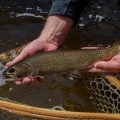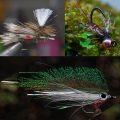How to Tie a Travis Para Ant
Producer: Tim Flagler
This is Tom Travis’s Para Ant. I love both its simplicity and its effectiveness. Even when I’m not seeing ants on or near the water, the Para Ant catches fish. They’re most commonly tied in either black or cinnamon.
For a hook, I really like the look of a ring eye for this pattern. Here, I’m going to use a Lightning Strike DF3 in size 18. Begin by getting the hook firmly secured in the jaws of your tying vise.
For thread, I load a bobbin with a spool of black UTC 70 Denier. Get your thread started on the hook shank, leaving just a little space behind the eye, and take a few wraps rearward before snipping off the excess tag. Continue taking thread wraps rearward to the start of the bend, then advance your thread forward until it hangs at about the hook point.
Black Super Fine dubbing is used to form the body of the fly. Pull an ample clump free from the packet and use it to create a 3” long, super slim noodle on your tying thread. With the noodle complete, start taking wraps with it to build up a bulbous segment at the back of the hook. Then advance your thread forward to the initial tie-in point.
Pull another clump of dubbing free from the packet, approximately half the size of the first. Create a dubbing noodle on your tying thread that’s only about 2” in length, and again, very slender. Start taking wraps with it to produce a bulbous front segment on the fly, and end with bare tying thread right in the middle of the bulge.
I’m going to use yellow McFlylon for the post, but orange, bright green and white are also popular. Snip an inch-and-a-half long segment free then divide it in half lengthwise, and locate the midpoint of the segment. Place the midpoint over top of your tying thread and take wraps to anchor the material in the center of the front segment. The dubbing will keep the McFlylon from spinning around the hook shank. Begin taking posting wraps up, maybe 5 or 6 turns, then back down. You’re not really building a full post here, just getting one started.
For hackle, I’m going to use a single feather from a black neck but Grizzly or brown will also work. Measure to make sure the hackle is approximately the right size, here, 18. I like to do this before pulling the feather free from the skin. Preen down and strip off the lower webby fibers from the stem. Then snip the bare stem off to about 1/4” in length. Place the snipped-off stem against the near side of the hook, like so, and start taking thread wraps up the post. The hackle stem will help to further stabilize the post as you go up. With the post 1/8” in height, take thread wraps back down to the dubbed body, then around to behind the hook eye. Pick up your whip finish tool, pull the hackle feather out of the way, and do a 4 or 5 turn whip finish, seat the knot well and snip or cut your tying thread free.
Deposit a drop of UV cure resin onto a scrap piece of paper and, using your bodkin, pick up just the smallest amount. Lightly coat the entire thread-wrapped portion of the post with the resin, making sure you have good coverage. Get hold of the hackle feather and start making clockwise wraps with it, up the post, 3 or 4 turns usually looks pretty good. When you get to bare McFlylon, reach for your UV torch and give the area a healthy bath of UV light to set the resin. You can then use the very tips of your tying scissors to carefully snip the excess hackle off close. Finally give the post a little twist and snip it off to about a hook shank in height.
And that’s the Travis Para Ant. Once you get the hang of tying these, you can crank them out at a pretty rapid rate.
How to Tie a Traditional Downhill or Oak Wet Fly
How to Tie a Trico Parachute











